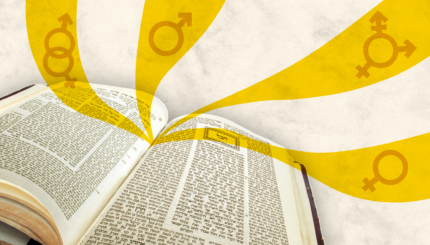Gender messages are all around us. From images in schoolbooks to images on bus ads, from conversations on the train to those on the big screen, from clothing conventions learned at school or on Fifth Avenue—everywhere we turn, we are subsumed in messages about what it means to be a “correct” or “normal” woman or man. Just this week there has been a heated debate on our Facebook feeds about whether there is room in our society for women to express anger without being dismissed for not being perky enough. Gender is everywhere.
In our research, we have been especially interested in how these gender messages get transmitted in Jewish educational institutions. Schools are big parts of our adult lives—as parents, community members, and former students ourselves. And certainly schools are a big part of our children’s lives. Events taking place in school today are likely to impact our culture for years to come For that reason, we have found it useful to examine the gender messages in schools, and to provide people with tools to ask the important questions about their educational settings.
Here are some useful questions for parents, teachers, students, lay leaders, and other interested members of the community to ask about the educational institutions around you:
1. Whose photos are on the walls? When you walk into a school (or synagogue, or JCC), take a look at the portraits hanging on the walls. Are there an equal number of men and women? If photos are male-dominated, find out why. For example, is it because only school presidents’ photos are displayed and the school has never had a female president? If that is the case, see Question 2. Take note also of the gender make-up of artwork displayed, or of historical figures displayed. If women and girls are underrepresented, start a conversation about it with the school staff and leadership.
2. Who are the lay leaders? Are women represented in lay leadership? Has your school ever had a female president? Are women encouraged to join the lay leadership—prepped in the “pipeline” for future roles as leaders?
3. What does the mission statement say about gender? Mission statements often give strong clues about the values and energies of the school leaders. If a mission statement dedicates a paragraph or more to its relationship with the State of Israel, for example, chances are this was the result of many hours of discussion on the topic, and an express commitment to the issue. Many schools, however, have little if anything written in their mission statements about commitment to gender equality. This may mean that it has never been discussed at length, or that it is not a high priority. Find out the history of your school and its commitment to this topic.
4. Who are the student leaders? Is there gender equality in student government? Do girls and boys have equal opportunities to become leaders? Flip through recent yearbooks and check for gender equality in leadership of clubs and councils. Where do boys stand out and where do girls stand out? For example, is there a place for girls in areas such as chess, the A-V club, or computers? Is there a place for boys in art, poetry, and dance? Find out what kinds of experiences students have had when they challenge gender expectations. For example, what happens when a girl wants to join the A-V club? Also, do girls’ sports get the same attention as boys’ sports—and the same funding? Try to find out from students what kinds of experiences they have had in this regard.
5. Who represents the school at public events and assemblies? In one coeducational day school, a parent was surprised to find out that the school’s model seder had only boys on stage. When she inquired about this with the principal, he told her that it wasn’t “intentional”—each class was told to select a representative, and every single class happened to choose a boy. Check to see if there is equal representation and equal opportunity in public activities.
6.
Who leads ritual and prayer? Even in early childhood, prayer and ritual are a significant part of students’ experiences in Jewish schools. In many cases, even in kindergarten, children receive the message that the boys’ job is to lead while the girls’ job is to choose songs or distribute papers. In upper classes, gender differences in expectations around ritual are further exacerbated. In many schools, boys are expected to pray more frequently or for longer periods than girls, boys are expected to come to school earlier than girls, boys’ prayer facilities are nicer than girls’, and boys receive more attention and training in areas related to prayer. Take note of the gender messages around prayer, and find out how these messages affect students’ attitudes towards prayer – and towards gender.
7.
What kinds of roles are boys and girls given around Shabbat? Another gender-laden Jewish topic is Shabbat. In many schools, the “Ima shel Shabbat” [Shabbat mother] and “Abba shel Shabbat” [Shabbat father] are fixtures from early on. In some schools, the girl is expected to bring baked goods while the boy is expected to recite the Kiddush. What are the messages around these gender-segregated demands? How do they affect families that do not fit neatly into this “standard” gender model—such as single-parent families, blended families, or single-sex families? How do girls feel knowing that they have no reason to learn to recite blessings? How do boys feel learning that the meaning of being a boy is to always lead girls?
8. What adjectives are used to describe boys and girls? Take note of how girls and boys are described in newsletters, websites, report cards, and public events. Often girls are commended for being “caring,” “kind,” or “giving,” while boys are praised for their “intelligence,” “ingenuity,” and “courage.” Take note of gendered adjectives in your school, and start a school discussion about it.
9.
Whose pictures are in the newsletter and website – and what are they doing? Similarly, whose photos appear on the school’s website and other materials? And in what capacity? Are girls shown in the same kinds of active, energetic, and intelligent roles as boys? Are girls shown engaging in sports, math, science, and leadership? One camp that we worked with had almost no photos of girls on its website. But when we pointed it out to them, they took note and made changes. Today, the site shows photos of girls everywhere, including doing sports and teaching.
10. Are there men on the educational staff, and in what positions? Teaching is a female-dominated profession, which has repercussions for status and salary. What makes it worse is the inverted pyramid—that often the few men on staff are quickly advanced and promoted. It is not uncommon to see a staff meeting that is almost exclusively female, with the only man in the room constituting the boss. Do dynamics like this exist in your school setting? How do women feel about the gender make-up of the staff?
We hope these questions are helpful. For more information and insights, you can read our book, or feel free to contact us for consultation or to find out how we can help you along in this important process.
The Visiting Scribes series was produced by the Jewish Book Council‘s blog, The Prosen People.
The Jewish world is full of debates. Get the latest in MyJewishLearning’s weekly blogs newsletter.
seder
Pronounced: SAY-der, Origin: Hebrew, literally "order"; usually used to describe the ceremonial meal and telling of the Passover story on the first two nights of Passover. (In Israel, Jews have a seder only on the first night of Passover.)


